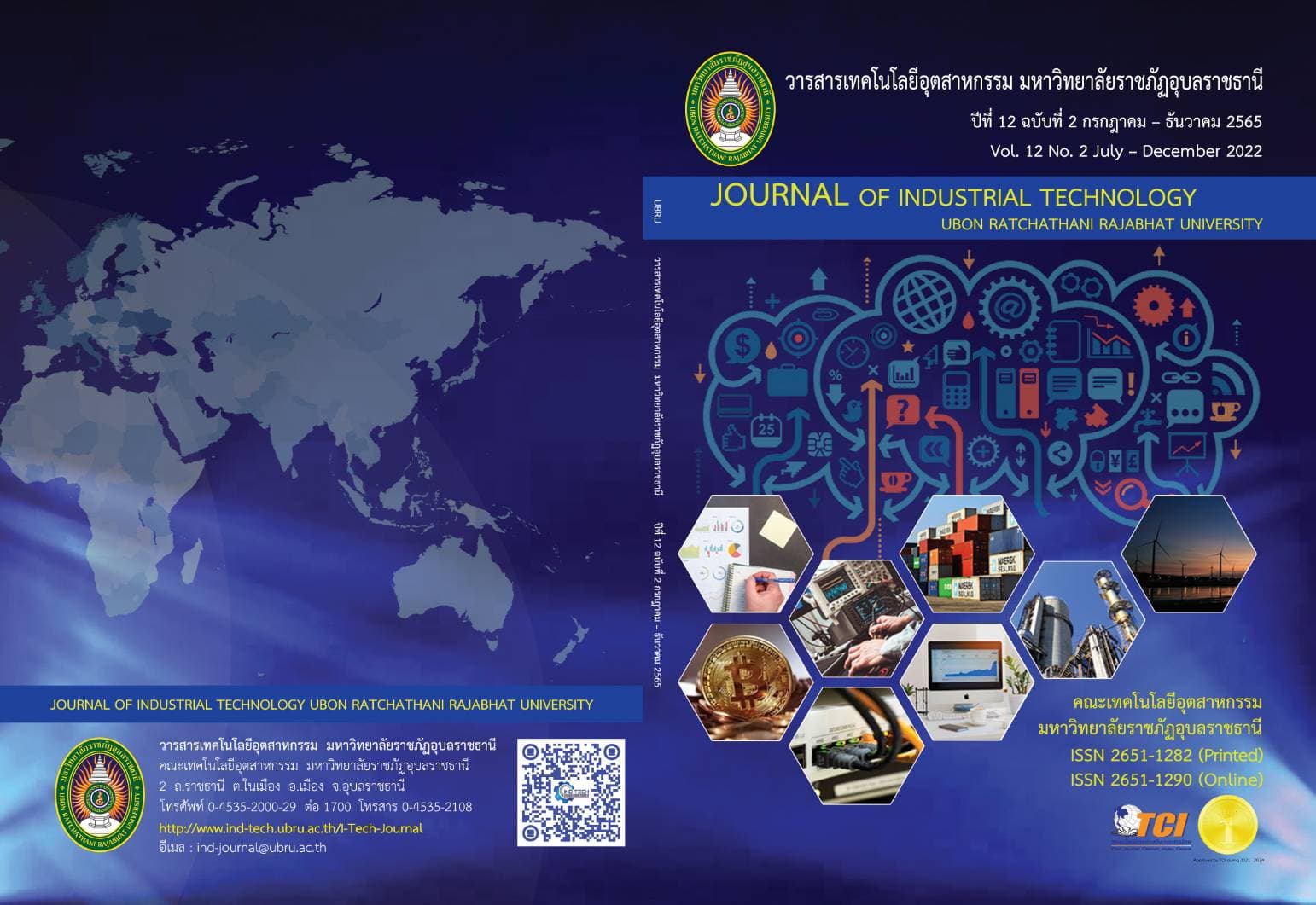การหาสภาวะที่เหมาะสมในการเชื่อมเหล็กกล้าคาร์บอนปานกลางด้วยกระบวนการเชื่อมแก๊สทังสเตนอาร์คแบบลวดร้อนโดยใช้วิธีทากูชิ
Main Article Content
บทคัดย่อ
ทากูชิเป็นเทคนิคสำหรับการออกแบบและทำการทดลองจนเป็นกระบวนการค้นหาผลลัพธ์ที่เกิดขึ้นที่ได้จากปัจจัยในการนำมาทำการทดลอง เครื่องมือที่ใช้สำหรับวิธีทากูชิ คือ ออโธกอนอลอะเรย์ โดยใช้อัตราส่วนสัญญาณต่อเสียงรบกวน ซึ่งจะทำการวัดค่าทั้งสอง คือ อัตราส่วนสัญญาณต่อเสียงรบกวนของจำนวนตัวแปรในข้อมูลของผลตอบและเพื่อให้เข้าใกล้ค่าเฉลี่ยของผลตอบของเป้าหมายที่ต้องการมากที่สุด ดังนั้นการวิจัยนี้จึงนำวิธีทากูชิมาออกแบบการทดลองเพื่อศึกษาปัจจัยที่เหมาะสมที่สุดของกระบวนการเชื่อมแก๊สทังสเตนอาร์คแบบลวดร้อนบนเหล็กกล้าคาร์บอนปานกลางต่อการดูดซับพลังงานของแนวเชื่อม โดยศึกษาปัจจัยของกระบวนการผลิต ได้แก่ กระแสไฟเชื่อม กระแสไฟลวดร้อน และความเร็วในการเชื่อม จากการทดลองพบว่าปัจจัยในการเชื่อมที่เหมาะสม คือ การปรับกระแสไฟเชื่อมที่ 150 แอมแปร์ กระแสไฟลวดร้อน 180 แอมแปร์ และความเร็วในการเชื่อม 100 มิลลิเมตร/นาที ให้ค่าเฉลี่ยในการดูดซับพลังงานสูงสุดที่ 56.40 จูล ค่าอัตราส่วนสัญญาณต่อเสียงรบกวนอยู่ที่ 35.02 การทดลองซ้ำเพื่อยืนยันพบว่าค่าที่ได้มีค่าใกล้เคียงกับการทดลองครั้งแรกด้วยการคำนวณโดยวิธีทากูชิถือว่าเป็นค่าที่ยอมรับได้โดยการปรับค่าสัมประสิทธิ์การตัดสินใจมีค่าเท่ากับร้อยละ 97.37 ดังนั้นวิธีการทากูชิสามารถนำมาออกแบบกระบวนการเชื่อมแก๊สทังสเตนอาร์คแบบลวดร้อนในการต่อเหล็กกล้าคาร์บอนปานกลางได้อย่างมีประสิทธิภาพ
Article Details

อนุญาตภายใต้เงื่อนไข Creative Commons Attribution-NonCommercial-NoDerivatives 4.0 International License.
บทความที่ได้รับการตีพิมพ์ในวารสารฯ ท้ังในรูปแบบของรูปเล่มและอิเล็กทรอนิกส์เป็นลิขสิทธิ์ของวารสารฯ
เอกสารอ้างอิง
Aichele, G., & Spreitz, W. (2001). Kostenrechnen und Kostensenken in der Schweißtechnik: Handbuch zum Kalkulieren, wirtschaftlichen Konstruieren und Fertigen. Verlag für Schweißen und Verwandte Verfahren, DVS-Verlag.
Ding, J., Colegrove, P., Mehnen, J., Ganguly, S., Almeida, P. S., Wang, F., & Williams, S. (2011). Thermo-mechanical analysis of Wire and Arc Additive Layer Manufacturing process on large multi-layer parts. Computational Materials Science, 50(12), 3315-22.
Wang, F., Williams, S., Colegrove, P., & Antonysamy, A. A. (2013). Microstructure and mechanical properties of wire and arc additive manufactured Ti-6Al-4V. Metallurgical and materials transactions A, 44(2), 968-77.
Hori, K., Myoga, T., Shinomiya, M., Watanabe, E., Kusano, K., Takuwa, T., & Hafuri, M. (1989). U.S. Patent No. 4,801,781. Washington, DC: U.S. Patent and Trademark Office.
Bai, J. Y., Fan, C. L., Yang, C. L., & Dong, B. L. (2016). Effects of thermal cycles on microstructure evolution of 2219-Al during GTA-additive manufacturing. The International Journal of Advanced Manufacturing Technology, 87(9), 2615-23.
Yilmaz, O., & Ugla, A. A. (2017). Microstructure characterization of SS308LSi components manufactured by GTAW-based additive manufacturing: shaped metal deposition using pulsed current arc. The International Journal of Advanced Manufacturing Technology, 89(1-4), 13-25.
Spaniol, E., Ungethüm, T., Trautmann, M., Andrusch, K., Hertel, M., & Füssel, U. (2020). Development of a novel TIG hot-wire process for wire and arc additive manufacturing. Welding in the World, 1-12.
Tanmay, Chandra, M., Sharma, S. et al.(2021). Study of Mechanical and Metallurgical Properties of Cold and Hot Reciprocating Wire TIG Welding on AISI 1035 Carbon Steel. J. Inst. Eng. India Ser. D .
He, H., Wu, C., Lin, S., & Yang, C. (2019). Pulsed TIG welding–brazing of aluminum -stainless steel with an Al-Cu Twin Hot wire. Journal of Materials Engineering and Performance, 28(2), 1180-9.
Shinozaki, K., Yamamoto, M., Nagamitsu, Y., Uchida, T., Mitsuhata, K., Nagashima, T., & Arashin, H. (2009). Melting phenomenon during ultra-high-speed GTA welding method using pulse-heated hot-wire. Quarterly Journal of the Japan Welding Society, 27(2), 22s-6s.
Wei, H., Zhang, Y., Tan, L., & Zhong, Z. (2015). Energy efficiency evaluation of hot-wire laser welding based on process characteristic and power consumption. Journal of Cleaner Production, 87, 255-62.
Kechagias, J. D., Aslani, K. E., Fountas, N. A., Vaxevanidis, N. M., & Manolakos, D. E. (2020). A comparative investigation of Taguchi and full factorial design for machinability prediction in turning of a titanium alloy. Measurement, 151, 107213.
Rafidah, A., Nurulhuda, A., Azrina, A., Suhaila, Y., Anwar, I. S., & Syafiq, R. A. (2014). Comparison design of experiment (doe): Taguchi method and full factorial design in surface roughness. In Applied mechanics and materials (Vol. 660, pp. 275-9). Trans Tech Publications Ltd.
Yu, G., Chen, X., Zhang, B., Pan, K., & Yang, L. (2020). Tensile-Shear Mechanical Behaviors of Friction Stir Spot Weld and Adhesive Hybrid Joint: Experimental and Numerical Study. Metals, 10(8), 1028.


